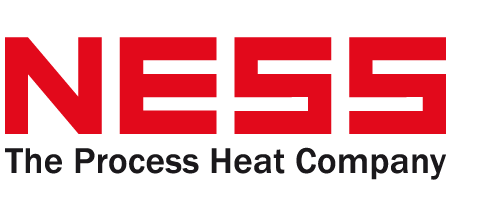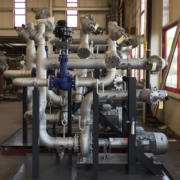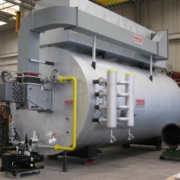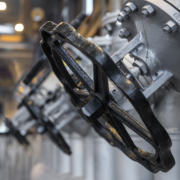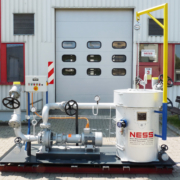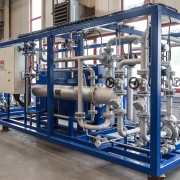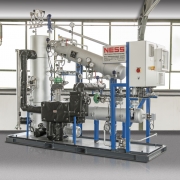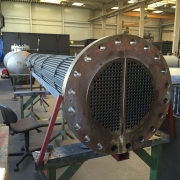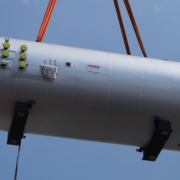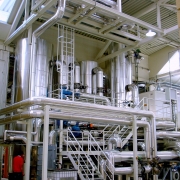Pump monitoring and maintenance in large-scale thermal process systems
Our friends from HEAT EXCHANGER WORLD have published a great article, which we do not want to withhold from you. Enjoy reading.
Large-scale heating plants, although complex and exposed to high loads, can operate over long periods without interruption and with low maintenance. To achieve this goal two aspects are important.
By Dominik Weidler, Chief Information and Technology Officer at NESS Wärmetechnik GmbH
The first aspect is a professional commissioning and maintenance of the pumps, which includes precise alignment of the pumps and venting the pumps before the commissioning and before each start-up. In order to avoid and detect possible problems in the system at an early stage, one – and that is the second aspect – has to take monitoring into account during the planning phase. An important element here is pump monitoring, as the pumps are central to the function of the system. In heat transfer systems with liquid heat transfer media, the highest demands occur on the pumps of the system. Depending on the system pressure and the heat transfer medium used, the specifications of the optimal pump differ. In general, canned motor or magnetic drive pumps are technically the most suitable. At the same time, however, these pumps are significantly more expensive to purchase than classic pumps with mechanical seals. From a purely economic point of view, in many cases it even makes sense to use pumps with mechanical seals and – through additional monitoring – to compensate for the somehow higher risks.
Key factors
Three indispensable factors should be included in a pump-monitoring concept: Bearing temperature, pump vibration, and leakage quantity. These help to detect problems and wear on pumps at an early stage and to optimally integrate maintenance and repair into the production cycle. Due to the temperature and viscosity of the fluid used, pumps in such systems have to deliver high performance continuously over long periods. Leakage, vibration and rising bearing temperature are the most common disturbance factors in pump operation and therefore it is useful to monitor them. The monitoring modules described here should have three levels: Normal operation, alarm when approaching the limit values, and shutdown when exceeding the specified
limit values. This not only serves for occupational safety and environmental protection, it also protects the pump unit and its immediate surroundings from damage and contamination.
Before start-up
Most pumps in large and medium sized thermal process systems are base plate pumps. To ensure a long lifetime, one has to align the base plate accurately. This reduces vibration to a minimum and extends the lifetime of the mechanical seals. The second important step when starting up a pump
is to vent the pump beforehand. If the pump is not vented during the start-up, there is an increased risk of damaging the pump. Higher friction leads to more vibration and higher temperatures at the mechanical seal and soon to a failure of the pump. All standardized pumps come with a vent plug – often with a ¼’’ thread and hexagonal head screw. The downside of this simple solution is that an Allen key has to be used and that it is almost impossible to vent without soiling the pump housing. That in turn does not only look unprofessional, but also increases the risk of fire. A simple solution for this problem is an additional pump vent with a stainless steel needle valve for process temperatures up to 350 °C for safe venting. It is easy to retrofit such a solution to all standardized pumps with the abovementioned thread and vent plug.
Wear can lead to leakage
If leakage occurs in the area of the pump, it endangers the function of the entire system. The mechanical seals in pumps are wearing parts with a defined service life whose tightness steadily decreases during operation. With increasing material loss, small amounts of the heat transfer medium leak out. At the beginning, with sufficient protection and timely maintenance, this is unproblematic.
If the lifetime of this wearing part ends, the time to the defection is a decisive factor. The quicker an increasing leak can be detected, the less the production process will be disrupted. Of course, it is even better to replace the wearing part before it finally fails. This is possible through continuous monitoring. Leakage monitoring is therefore an important add-on part of every pump. There are retrofit modules that are suitable for all systems, differ slightly according to pump type and can be integrated with little effort. The mode of operation is easy to understand: Continuous monitoring of the fluid leaking through the mechanical seal by means of a level sensor allows conclusions to be drawn about the condition of the seal and about further developments. In addition to the amount of leaked fluid, the temperature in the collection container is also monitored. If the mechanical seal fails, a larger quantity of hot fluid enters the collection container and does not cool down on the short way there. This means that the temperature in the collection container rises quickly and the temperature sensor reports that the limit value has been exceeded. This ensures that even a short-term leakage is quickly detected and an automatic shutdown is initiated in an emergency.
Vibration causes damage
Pumps that are well maintained and in good working order run with minimal vibration and noise. Increasing vibrations are often an indication of wear, spontaneous increases allow conclusions to be drawn about damage. Costly wear of moving parts and damage can be prevented by monitoring the occurrence of vibrations and implementing maintenance measures at an early stage. With a pump vibration monitoring module, this can be prevented in advance. In this case, the measurement is carried out via a piezo resistive sensor whose electrical resistance changes by compressive and tensile forces. The movement of a component is transferred to a fixed surface, or the reduced distance causes compression of the sensor, the effect of which on the electrical conductivity can be measured. The collected data not only provides information about the strength and increase of a vibration, but also about irregularities. If a spontaneously occurring unbalance points towards a critical value that makes damage to the system probable, the system must go to a shut down.
Detection of heat generation in the bearings
Friction generates heat – this is not always beneficial for components, but in a normal state it can be predicted and planned for. In the bearings of the pump, mechanical energy is converted into heat by friction between the individual components. In a maintained condition, the heat generated in the components moves within an intended tolerance range, even in continuous operation. Exceeding the tolerance values indicates the need for maintenance and warns of imminent damage and failure.
If temperature values are reached in the bearings that impair the pump’s performance or increases wear of material in a way that can lead to system damage, the module warns the technicians, but should also be able to initiate an emergency shutdown to avert damage and danger if the temperature continues to rise.
Safety through user-friendliness
The use of monitoring tools is often considered cumbersome and time-consuming because values have to be checked and read at different pumps. Reading at the pump in large operations with (several) widely distributed pumps is tantamount to spending a lot of time and creating cumbersome routines. Centrally arriving values are an enormous relief in everyday production. Therefore, it is advisable to integrate the modules into the existing system control. This means that in day-to-day production, there is no need to read data from the pump; the data is collected centrally in the control centre. Malfunctions are reported and the affected pump can be identified immediately.
Conclusion
In this article the benefits of well-executed maintenance for pumps in thermal process plants as well as monitoring the essential parameters of pumps – bearing temperature, pump vibration and leakage quantity – have been shown. With this knowledge in mind, it is often not necessary to buy more sophisticated pumps, like canned motor or magnetic drive pumps for standard thermal processes, as one can achieve the same level of reliability when adding monitoring tools to a pump with mechanical seal. Of course, this is not true for every single case and you have to look at each process on its own.
The original article you can find here
For the full trade magazine visit https://heat-exchanger-world.com/
